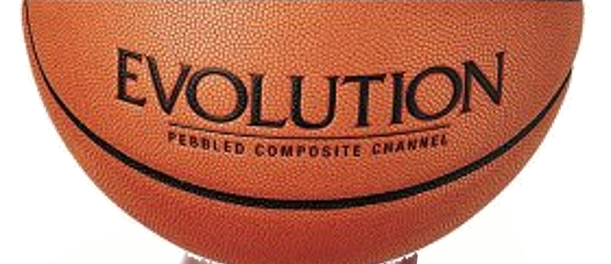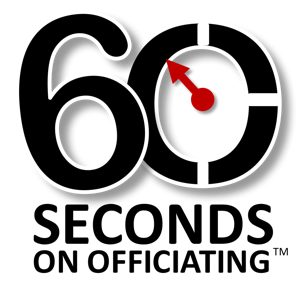
Three Dead Ball Mechanic Tweaks
Here are three amazingly simple things you can do (starting today) during a “dead-ball” to make you look better as an official.
While it’s significantly more important to focus on “live ball mechanics” such as primary coverage areas, rotations, and communication — there are a few extremely simple mechanics that can improve your “look” as an official with very little effort.
While these simple “mechanical tweaks” might seem trivial to many folks — the attention to detail can be the “image of difference” when being observed live or on video. So here they are.
Tweak #1: Holding the Dead Ball
While watching an NBA game a few years back I observed the official holding the ball after a time-out in his fingertips – right about shoulder height with the label of the ball perfectly aligned for the crowd (and photographers) to read.

This caught me as being “intentionally” done versus just an accident. The referee was waiting for the teams to return to the floor and begin play. His demeanor and stature while holding the ball in this manner demonstrated confidence, power, and professionalism. There was attention to detail in every aspect of his game and I quickly adopted this tiny little visual trick.
Instead of holding the ball at your waist (or hip) which is a less powerful position you might consider holding the ball above shoulder height:
- Prior to tossing the jump ball to start the game / overtime periods.
- During time-outs when spotting the ball.
- During lengthy delays prior to inbounding the ball.
- Unlike the picture (on right) I would even recommend putting the label of the ball in it’s proper position for reading. (It’s the icing on the cake)
Tweak #2: Spitting the Whistle Out of Your Mouth
This is an easy one that some folks have extreme difficulty with. Whenever the ball is dead – the officials should “spit” their whistles out of their mouths. This is most important for the calling official to drop the whistle after blowing to start their preliminary signal (at the spot of foul or violation) without the encumbrance of a plastic object in their face.
If your partner blows … keep the whistle in for a moment in case it’s needed … but then drop it while you switch to your next on-court position. Never walk around with the whistle in your mouth. In fact you might not even realize you are doing this unless reviewing a game video of yourself.
Always think about dropping the whistle when it’s not needed.
Tweak #3: Lock Down in the Reporting Zone
Working with some cadets recently I noticed the huge tendency to “walk & talk” when reporting a foul to the table. The remedy is quite simple.
If your FEET are moving — your LIPS should be still.
When your FEET stop — your LIPS can start talking.
This simple but effective technique will make you look so much better when reporting fouls, time-outs, etc. to the table. Plus, it’s the approved mechanic that many folks seem to forget.
The same thing goes for your foul calling sequence at the spot of the foul.
- Come to a COMPLETE STOP – after your whistle and “fist-up” signal to stop the clock.
- Drop the whistle (remember Tweak #2)
- Feet are still (at the spot of foul) and now you can verbalize the color and number with your preliminary signal.
- Lips stop — and now you can move to your next spot, which is the reporting zone for table communication.
- Rinse and repeat. Same thing over again. Feet are still and you can start talking to the scorer from the reporting area.
One last thing to consider. If the actual “scorer” is not giving you eye-to-eye contact while reporting the foul — just STOP and wait for him/her to look up. Many good score keepers will pre-record the foul to stay ahead of you but it’s important to minimize errors and gain that eye contact directly with the “person on the pencil” before speaking. I recall an incident from a game last year when the scorer was almost removed from her duties for not paying attention during the game when our crew was reporting the fouls.
While these tiny tweaks might seem insignificant, when you incorporate them into the total officiating package, professionalism will be raised and create the “image of difference” referee.
If you have any minor “dead-ball” tweaks we welcome you to share them with our “60 Second” community below.

Great reminders, Billy. Thanks. I really enjoy reading your columns. Great work!
I was taught 35 years ago to put ball on hip side of direction the ball will be going. Ball in front of me is to remind me the ball is going down and behind we are staying here. It is amazing when you are ready to go and can’t remember what direction and who gets it. It is a loss of concentration but it does happen. I like the poise factor and will try it with some variations of left hand going left and right hand going to my right for sidelines.
Funny, when I first started out I used to hold the ball up as described, just like my mentor. Don’t know what happened but I only do it maybe a third to the time now. This article was tremendous in reminding me of these little things all add up. Thanks
reffing for over 20yrs. i have learned that doing the “little things” are the things that make us look professional, we all can ref, but when another official is in the stands oberserving, one can pick out the official who has the most seniority,just in the way he performs the “little things”. The 3 “tweaks” mention in this sector are just a few will that help us all to look better throughout the remaining season. Thanks
Eric S…This is my 3rd season, and as a newer ref these tips are GREAT. There is nothing better than a Ref crew looking as if they worked together for years. I always try to incorporate these lessons into my game. Please keep them coming.
Comments/Observations from the IPT (Important People Table) on dead ball mechanics.
(1) Reporting Foul: Come to the reporting area, STOP, verbalize color then number using one hand for indicating number. I know that using two hands looks trendy, cool and NBA-ish but only the numbers ’00, 11, 22, 33, 44 and 55′ might be exceptions for using two hands. Case in point. CR or slot ref calls shooting foul which stays in front court opposite the table. Doesn’t come to the reporting area even though he will switch with trail, indicates with two hands that ’42’ is the offender. However, ’42’ from the IPT perspective looks like ’24’. This is a common flaw that officials commit when using two hands to indicate number rather than one hand. Now we have number ’24’ on the score clock displaying the offender rather than ’42’ and the CR or calling official is not validating or looking at the score clock to check and for that matter neither are the other officials.
(2) Reporting Foul: Same official or CR or slot ref calls shooting foul which stays in front court opposite the table. Again, he doesn’t come to reporting area, verbalizes and indicates that ‘1 – RED’ is the offender. Score book person is baffled since there is no ‘1 – RED’ in the book or on the court nor in the arena and score clock operator has already punched-in ‘1 – RED’. Fortunately the shot clock operator was alert and caught the discrepancy which none of the officials on the floor recognized.
(3) If we [officials] are going to enforce players to keep jerseys inside shorts, then we [officials] should make sure our jerseys are tucked-in or will remain tucked-in. Buy a pair of suspenders guys rather than continuously and unprofessionally adjusting jersey during dead ball!
(4) CR or slot ref should use ‘quiet’ wrist flick rather than very visible and disconcerting hand/arm count/gesture on free-throw (e.g., live ball).
Here’s a couple of pointers received via email from former collegiate official Don Rutledge who has officiated games in six major conferences and 18 consecutive NCAA men’s postseason tournaments, including two Final Four championship games.
1. Before you put the ball in play “Sweep the floor” with your eyes.
– check the table
-check both benches
-check your partners
-check the players
-check the clock
-check the fans
2. A trick to learn for checking the clock during games is …Every time you cross a “line” look at the clock.
Thanks for the great suggestions.
The first tip goes against officiating manuals for putting the ball in play. Correct “mechanic” is to hold ball on hip side in direction ball will be going. I like the idea of holding it on fingertips, just sayin, it is not prescribed.
I think stopping to report to the table is silly in the men’s game.
If it’s that important, I’d think the women and the NBA would adopt this mechanic.
I also agree that stopping to report fouls looks choppy. It is not hard from the table to see someone flashing numbers on the move. I think verbalizing the number is even more important which many officials don’t do well. It is the verbalizing that shows good communication and confidence in calls.
Thanks Billy
Great things discussed for the personal improvement and development of a referee….
does this sight ever change ?? i have not seen anything new in a year..